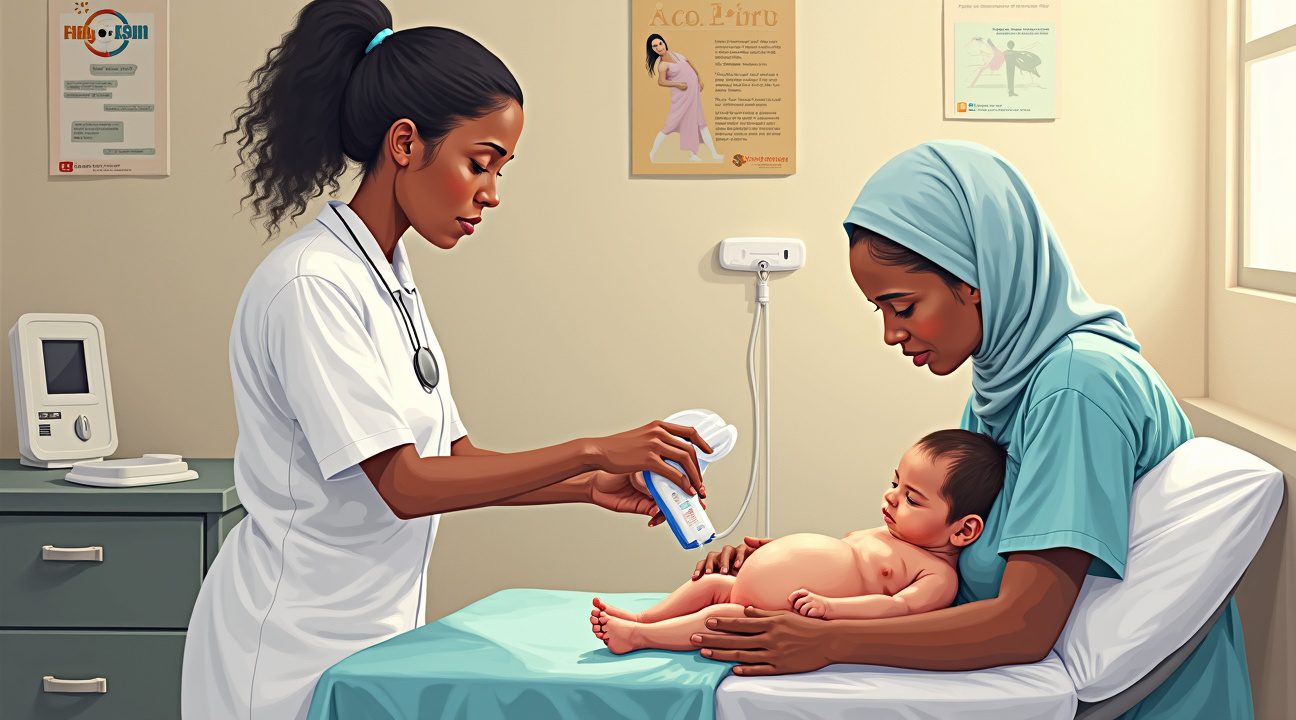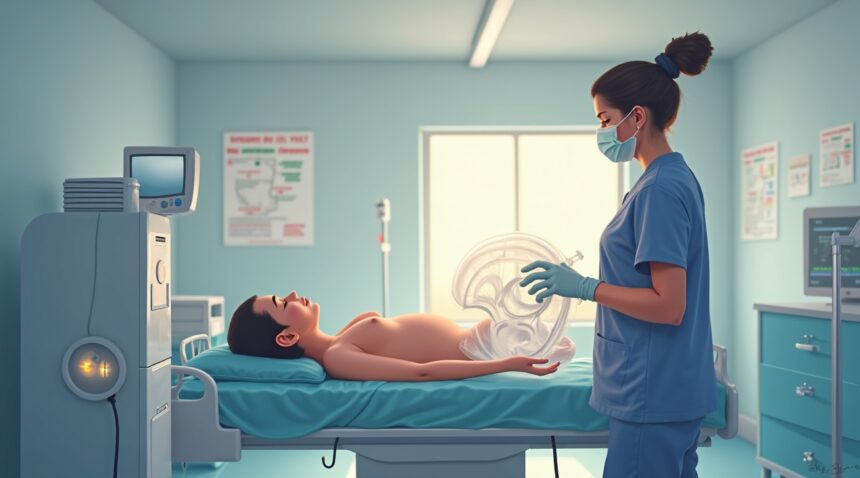The Odon Device represents a revolutionary approach to assisted childbirth, born from an Argentine car mechanic’s ingenious adaptation of a wine cork extraction technique into a life-saving medical innovation.
This groundbreaking pneumatic delivery system offers a safer alternative to traditional forceps and vacuum extraction methods, with the potential to significantly improve birth outcomes for millions of women facing complicated deliveries.
Key Takeaways
- Innovative Origins: Jorge Odón, a car mechanic from Argentina, invented the device in 2006 after being inspired by a wine cork removal trick. This story highlights how medical breakthroughs can emerge from the most unexpected sources.
- Superior Safety Profile: Clinical trials report a 93% correct insertion rate and a 71% success rate on the first attempt for deliveries. Notably, no severe perineal tears have been observed, and the device causes significantly less trauma than conventional tools like forceps or vacuum devices.
- Global Health Impact: The Odon Device is specifically designed for the 13 million complicated births that occur globally each year. It holds promise in reducing the alarming statistic of 800 daily maternal deaths due to preventable complications, especially in low-resource regions.
- Accessible Design: Estimated to cost around $50 and requiring only minimal training, the device is single-use and sterile. These features allow healthcare workers without advanced medical education to safely operate it, which is vital for underserved communities.
- Development Status: Now renamed OdonAssist, the device is under regulatory review guided by medical technology company Becton Dickinson. Additional randomized-controlled trials are currently underway to secure regulatory approval and enable widespread clinical use.
A Car Mechanic’s Wine Cork Solution Could Revolutionize Childbirth
Jorge Odón never imagined that his automotive repair skills would lead to a groundbreaking medical innovation. Working as a car mechanic in Argentina, Odón discovered an ingenious solution that could transform how difficult births are managed worldwide. His inspiration came from an unexpected source – a simple trick for removing a cork that had fallen into a wine bottle using a plastic bag.
From Workshop to Medical Laboratory
In 2006, Odón created his first prototypes using basic materials from his workshop environment. I find it remarkable how he constructed these early versions with a sewn plastic sleeve, testing the concept on a doll placed inside a glass jar to simulate the extraction process during childbirth. This unconventional approach demonstrated how innovation often emerges from the most unexpected places, bridging completely different fields of expertise.
The device’s potential becomes clear when considering the massive global need it addresses. Each year, more than 13 million births encounter complications worldwide, resulting in approximately 800 maternal deaths daily from primarily preventable issues. These staggering numbers highlight why Odón’s invention caught the attention of major health organizations and medical technology companies.
Clinical Development and Global Support
The Odon Device gained significant momentum when it attracted support from the World Health Organization and medical technology company Becton Dickinson. Early development and clinical evaluation took place in hospitals across Argentina and South Africa, where medical professionals could assess its effectiveness in real-world scenarios. This collaboration between a grassroots inventor and established medical institutions exemplifies how innovative thinking can emerge from unexpected sources.
The device works by using a plastic sleeve that’s placed around the baby’s head during delivery, allowing healthcare providers to gently assist with extraction when complications arise. This method potentially offers a safer alternative to traditional forceps or vacuum extraction methods, which can sometimes cause injury to both mother and child.
What makes Odón’s story particularly compelling is how it demonstrates that medical breakthroughs don’t always come from research laboratories or university medical centers. Sometimes, the most practical solutions emerge from everyday experiences and creative problem-solving. His background as a car mechanic provided him with hands-on mechanical intuition that proved invaluable in developing a device that could save countless lives during childbirth complications.

How the Revolutionary Design Works Without Forceps or Vacuum
The Odon device transforms assisted delivery through its innovative pneumatic system that eliminates the risks associated with traditional forceps and vacuum extractors. At its core, the device features a flexible polyethylene sleeve engineered with precise internal and external folds that allow it to conform naturally to the birth canal’s anatomy.
Core Components and Functionality
The device’s manual inserter comes equipped with an ergonomic handle and four strategically positioned flexible spatulas that guide proper placement during delivery. These spatulas ensure healthcare providers can position the device accurately without causing trauma to maternal tissues. A built-in progress indicator provides real-time confirmation of correct positioning, giving medical professionals confidence throughout the procedure.
The revolutionary aspect lies in the inflatable air chamber, commonly called the cuff, which creates a gentle but secure grip around the fetal head. This pneumatic system distributes pressure evenly, contrasting sharply with the concentrated force points that traditional instruments create. The air cuff can generate up to 19 kg (42 lb) of traction force while maintaining this distributed pressure pattern.
A protective plastic cup at the device’s tip shields the baby’s head from direct contact with rigid components. This design consideration reflects the careful engineering that prioritizes infant safety throughout the delivery process. The entire system operates without requiring electricity or water, making it practical for use in various healthcare settings, from advanced hospitals to resource-limited environments.
Each Odon device arrives as a single-use, sterile unit that eliminates cross-contamination risks between patients. Healthcare providers can immediately deploy the device without sterilization procedures or equipment maintenance concerns. The OdonAssist system represents a paradigm shift from mechanical extraction methods that have remained largely unchanged for centuries.
The device’s effectiveness stems from its ability to work with the body’s natural delivery mechanisms rather than against them. While forceps can cause facial nerve injuries and vacuum extractors may lead to scalp lacerations or intracranial bleeding, the Odon device’s distributed pressure system significantly reduces these complications. The pneumatic grip adapts to different head shapes and sizes, providing consistent performance across diverse patient populations.
Medical professionals appreciate the device’s intuitive operation, which doesn’t require extensive retraining or specialized expertise. The clear visual indicators and straightforward deployment process enable confident use even in high-stress delivery situations. This accessibility factor proves particularly valuable in emergency scenarios where quick, safe intervention becomes critical for both mother and baby. Much like how innovative robotics reshape our understanding of mechanical possibilities, the Odon device redefines what’s achievable in obstetric care through thoughtful engineering.
Clinical Results Show Promise for Safer Deliveries
The Odon device has demonstrated encouraging results in its initial clinical trials, offering hope for safer and more efficient assisted deliveries. A pilot study involving 49 women provided valuable insights into the device’s real-world performance and safety profile.
High Success Rates in Clinical Application
The clinical pilot revealed impressive success metrics that position the Odon device as a promising alternative to traditional assisted delivery methods. Correct insertion occurred in 93% of cases, demonstrating that healthcare providers can effectively implement this innovative technology. First-attempt successful delivery rates reached 71% among those cases where the device was properly positioned, indicating strong clinical efficacy.
Delivery times averaged between 5-7 minutes in complicated labor scenarios, representing a significant improvement over prolonged difficult births that might otherwise require more invasive interventions. This rapid delivery capability could prove crucial in emergency situations where quick resolution becomes essential for both maternal and fetal wellbeing.
Safety Profile and Maternal Outcomes
The safety data from the clinical pilot provides reassurance about the device’s gentle approach to assisted delivery. Perineal tear analysis showed that 59% of women experienced first- or second-degree tears, which fall within acceptable ranges for assisted deliveries. Importantly, no severe third- or fourth-degree tears occurred during the study period, suggesting the device may reduce the risk of serious perineal trauma compared to traditional forceps or vacuum extraction methods.
All neonates were delivered alive and vigorous, with no serious adverse outcomes reported for either mothers or infants. Follow-up examinations at 6 weeks and 1 year for a subset of participants confirmed the absence of long-term complications, though researchers continue monitoring participants to establish comprehensive safety profiles.
The promising clinical results have sparked interest in the medical community, similar to how breakthrough discoveries often generate widespread attention before thorough validation.
Development status remains ongoing, with the device still requiring additional randomized-controlled trials before regulatory approval. These future studies will directly compare the Odon device against established methods like forceps and vacuum extraction to definitively establish safety and efficacy advantages. The randomized clinical trial design will provide the rigorous evidence needed for widespread clinical adoption and integration into standard obstetric care protocols.
Current results suggest the device could revolutionize assisted delivery practices by offering a gentler, more predictable alternative that maintains high success rates while potentially reducing maternal trauma. Healthcare providers eagerly await completion of the randomized trials to determine whether the Odon device will become a standard tool in delivery rooms worldwide.

Targeting Complicated Births and Resource-Limited Settings
The Odon Device addresses a critical gap in obstetric care by providing a safer alternative for complex vaginal births. I’ve observed how this innovative tool specifically targets scenarios where traditional interventions fall short, particularly during prolonged second stage labor when mothers struggle to deliver naturally.
Applications for High-Risk Deliveries
The device proves invaluable in several challenging birth situations:
- Prolonged second stage of labor where maternal exhaustion hampers progress
- Large babies (macrosomia) requiring additional assistance during delivery
- Fetal distress situations demanding rapid but gentle intervention
- Abnormal presentations including transverse or breech positions
- Cases where conventional forceps or vacuum extraction pose excessive risks
Healthcare providers benefit from the device’s gentler approach compared to forceps and vacuum extraction. Unlike these traditional tools, the Odon Device reduces trauma to both mother and newborn while maintaining effectiveness. This advancement could significantly lower cesarean section rates, which currently represent a substantial portion of complicated deliveries worldwide.
The projected low cost of approximately $50 makes this technology particularly valuable for resource-limited settings. Healthcare facilities in low- and middle-income countries often lack access to expensive obstetric equipment or skilled specialists trained in complex forceps deliveries. The device’s minimal training requirements mean that healthcare workers can quickly learn proper application techniques without extensive specialized education.
This accessibility directly supports global health initiatives, particularly Sustainable Development Goal 3: Good Health and Well-Being. By improving maternal and neonatal outcomes in underserved regions, the device contributes to reducing preventable deaths during childbirth. I recognize how this aligns with broader efforts to make safe delivery care universally available.
The technology’s design philosophy emphasizes practicality over complexity. Rather than requiring sophisticated infrastructure or continuous maintenance, the device operates through simple mechanical principles that healthcare providers can easily understand and implement. This approach ensures reliability in environments where technical support may be limited.
For assisted vaginal delivery scenarios, the Odon Device represents a paradigm shift from traditional methods. Its gentle suction mechanism provides controlled assistance without the pressure points and potential complications associated with metal forceps. The technology offers hope for reducing maternal mortality and morbidity rates in regions where technological advances can make the greatest impact on human welfare.

Global Health Impact and Safer Birth Access
Conventional delivery assistance tools carry inherent risks that affect mothers and babies worldwide. Forceps and vacuum extractors require precise placement and can cause significant trauma during complicated births. These instruments often result in injuries to both the fetal skull and vaginal walls, creating additional complications during what’s already a challenging delivery process.
The Odon Device represents a breakthrough in reducing these delivery-related injuries. I find its design particularly impressive because it minimizes direct contact with the baby’s head and surrounding tissues. Unlike traditional extraction methods that grip or suction directly onto the fetal skull, this innovative tool works through a gentler mechanism that distributes pressure more evenly. This fundamental difference in approach dramatically reduces the likelihood of trauma during assisted deliveries.
Access to skilled birth attendants remains a critical challenge in many parts of the world. The Odon Device addresses this gap by simplifying the delivery assistance process. Healthcare workers with limited specialized training can learn to use this tool effectively, expanding the pool of practitioners capable of performing safer assisted deliveries. This accessibility factor becomes crucial in resource-poor settings where highly trained obstetricians aren’t readily available.
Transforming Birth Outcomes in Resource-Limited Environments
Remote and underserved communities often lack access to advanced medical equipment and specialized obstetric care. The Odon Device’s straightforward design makes it particularly valuable in these environments. Healthcare facilities that previously couldn’t offer safe assisted delivery options can now provide this service, potentially saving lives that might otherwise be lost during complicated births.
The device’s potential impact on maternal and infant mortality rates cannot be overstated. In regions where women die from preventable birth complications, having access to safer delivery assistance tools could mean the difference between life and death. Perinatal complications that currently result in tragic outcomes might be avoided with this technology’s implementation.
Consider how this innovation fits into the broader landscape of technological advancement. Just as other sectors have seen remarkable developments, transportation technology continues evolving to address complex challenges. The medical field similarly benefits from innovative solutions that tackle longstanding problems.
Rural health centers and community clinics stand to gain tremendously from the Odon Device’s introduction. These facilities often operate with limited budgets and staff, making complex medical equipment impractical. The device’s simplicity and effectiveness align perfectly with the operational constraints these centers face daily.
Training requirements for the Odon Device are significantly reduced compared to traditional assisted delivery methods. Healthcare workers can achieve proficiency more quickly, allowing for faster deployment in areas with urgent need. This shortened learning curve means that regions experiencing maternal health crises can implement solutions more rapidly than with conventional approaches.
The ripple effects of improved birth outcomes extend beyond individual families. Communities benefit when maternal and infant mortality rates decrease, as this strengthens the overall population health and economic stability. Women who survive childbirth can continue contributing to their families and communities, while healthy babies grow into productive members of society.
Global health organizations recognize the transformative potential of accessible medical technologies. The Odon Device exemplifies how innovation can bridge the gap between advanced medical care and underserved populations. Its development demonstrates that effective solutions don’t always require complex technology or extensive infrastructure.
Healthcare systems in developing countries face unique challenges that require creative solutions. The Odon Device addresses multiple barriers simultaneously:
- It reduces the need for highly specialized training
- Minimizes equipment costs
- Improves safety outcomes
This combination makes it an ideal tool for expanding access to quality obstetric care in regions where traditional methods have proven inadequate or unavailable.

Current Development Status and Path to Market
The Odon Device currently sits in regulatory limbo, awaiting the approvals necessary for commercial deployment. Becton Dickinson has taken the helm of development and manufacturing efforts, working to transform this innovative birth assistance tool from concept to clinical reality.
Regulatory Hurdles and Clinical Validation
Extensive evaluation through simulation studies and early human trials has demonstrated the device’s potential, yet regulatory bodies require comprehensive data before granting approval. The branded version, known as OdonAssist, specifically targets frontline birth attendants with its emphasis on disposability, sterility, and intuitive operation. These features address critical concerns in resource-limited settings where traditional vacuum extraction methods may pose infection risks or require specialized maintenance.
Manufacturing and Market Preparation
Becton Dickinson’s involvement signals serious commercial interest in bringing this technology to healthcare providers worldwide. The company’s manufacturing expertise and regulatory experience position them well to guide the device through the complex approval process. However, continued randomized-controlled trials remain essential before widespread medical use becomes possible.
Device training protocols are being developed alongside the clinical validation process, ensuring that healthcare workers can safely and effectively operate the OdonAssist system. This focus on education reflects lessons learned from other medical device implementations, where inadequate training has sometimes compromised patient outcomes.
The path forward requires balancing thorough safety validation with the urgent need for improved birth assistance tools in underserved regions. Clinical trials must demonstrate not only the device’s safety profile but also its effectiveness compared to existing extraction methods. Regulatory approval will depend heavily on these comparative studies, which examine outcomes such as:
- Maternal and fetal injury rates
- Successful delivery percentages
- Ease of use metrics
I anticipate that the regulatory review process will continue for several more years, given the stringent requirements for medical devices used in critical situations like obstructed labor. The device’s innovative mechanism represents a significant departure from traditional approaches, requiring regulators to carefully evaluate both its benefits and potential risks. Success in this regulatory phase will determine whether the Odon Device can fulfill its promise of reducing maternal and infant mortality in settings where cesarean sections aren’t readily available.
Sources:
NCBI (A Car Mechanic’s Idea for Easier Birth—The Odon Device),
Wikipedia (Odón device),
NCBI (The Odon device: a new tool for assisted vaginal deliveries),
Maternal and Neonatal Health Innovations (OdonAssist),
Engineering for Change (Odon Device)


